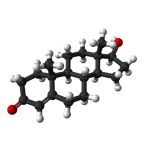Intermittent Hormone Therapy as Good as Continuous Treatment for Prostate Cancer
Intermittent androgen deprivation was shown to be as effective as continuous therapy in terms of overall survival for men with prostate cancer whose PSA levels were rising after initial or salvage radiotherapy.
Intermittent androgen deprivation was shown to be as efficacious as continuous therapy in terms of overall survival for men with prostate cancer whose prostate-specific antigen (PSA) levels are rising after initial or salvage radiotherapy. The results are published in the New England Journal of Medicine.

3D chemical structure of testosterone
Juanita M. Crook, MD, British Columbia Cancer Agency, Canada, and colleagues state that the dispersed treatment schedule also improves quality of life for patients.
The study randomized 1,386 men that had PSA levels greater than 3 ng/mL 1 year after primary or salvage radiotherapy for localized prostate cancer to either intermittent therapy of 8-month cycles (nontreatment periods were dependent on PSA levels), or continuous therapy. The median follow-up for the study was 6.9 years. Both groups received luteinizing hormone–releasing hormone agonist combined with a nonsteroidal antiandrogen. PSA levels were monitored every 2 months.
Median overall survival was 8.8 years in the intermittent group compared to 9.1 years in the continuous therapy group (hazard ratio of 1.02). The cumulative rate of disease-related death was 18% for the intermittent group and 15% for the continuous group after 7 years (P = .24). Deaths in the two groups were similar-268 in the intermittent group and 256 in the continuous therapy group.
Crook stated that she was not surprised that there was no difference in survival between the two groups. “Intermittent therapy can be recommended over continuous for this group of patients,” Crook said. “The study is the most definitive study to date comparing intermittent versus continuous androgen-deprivation therapy in patients with nonmetastatic cancer,” states Oliver Sartor, MD, of the departments of medicine and urology at Tulane University School of Medicine in New Orleans, in his commentary on the publication.
Quality of Life
No significant differences in adverse events were observed in the two groups. In the intermittent group, 35% of the men had a full testosterone recovery and 79% achieved pretherapy levels. According to the authors, physical and overall health symptoms were slightly better in the intermittent-therapy group, but the differences were not significant. For symptoms, those treated with intermittent therapy suffered fewer hot flashes (P < .001) and urinary symptoms (P = .006), scored better in desire for sexual activity (P < .001), and showed a trend toward lower fatigue (P = .07).
“The difference [in quality of life] is not as profound as one might expect,” state the authors, attributing the result partly to the timing of quality of life monitoring. The benefits are also dependent on the testosterone recovery, age, and status of each individual patient.
The authors highlight that although the cost of intermittent therapy is about one-third that of continuous therapy, the cost is partly offset by the greater follow-up required.
Based on these results, it is still not clear which men with early-stage prostate cancer and rising PSA levels should receive treatment, states Sartor in his commentary. The patient population is heterogeneous and “only a minority of men might be expected to have clinical consequences from their rise in PSA level,” said Sartor. Whether the men benefited from androgen-deprivation therapy for their slow-growing prostate cancer is not yet clear.